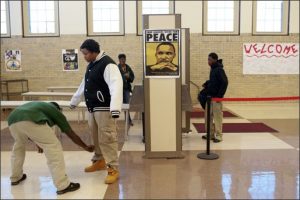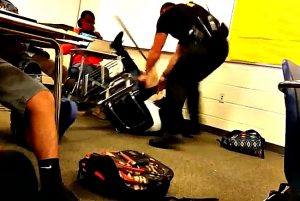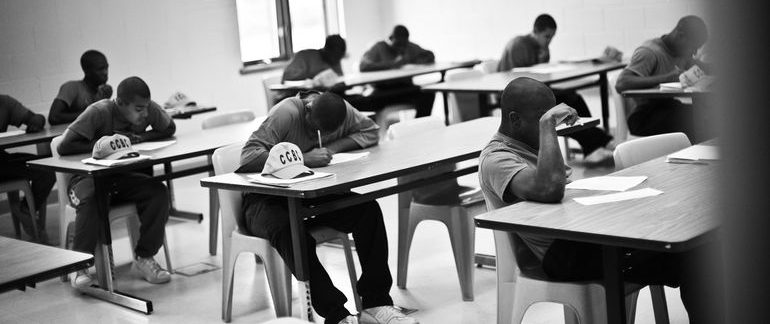The following articles lay out two different evaluations that are essential to better understanding zero tolerance as a whole. On the one hand, data driven studies are useful to evaluate a scientifically backed issue. On the other, numbers and data cannot simply be translated into changing perceptions. Thus the following is an examination of articles that deal with both. Professors Laura McNeal and Christopher Dunbar Jr.’s article, In the Eyes of the Beholder: Urban Student Perceptions of Zero Tolerance Policy demonstrate anecdotal evidence to present an argument for students not feeling safer under zero tolerance policy guidelines. The other article titled, Principal Attitudes Regarding Zero Tolerance and Racial Disparities in School Suspensions, is by Professors Anna Heilbrun and Dewey Cornell. They take on a data driven inquiry of zero tolerance policy under a similar guiding question as the former article, “are zero tolerance policies implemented effectively?” The following is a synthesis of anecdote and data in an effort to outline issues that are backed by data as well as the perceptions of those these policies are intended to serve.
Understanding perceptions of policies cannot be easily detached from those that enforce them. In the case of zero tolerance, McNeal and Dunbar point to these enforces as “street-level bureaucrats” (McNeal & Dunbar Jr., 2010, 297). In education these people are seen as teachers or security guards (McNeal & Dunbar Jr., 298). Thus questions were asked in a way that inquired about how students felt authorities enforced rules. Enforcement of rules of course is ideally equitable, but there has been mounting research to suggest that on the whole zero tolerance policy is anything but. Heilbrun and Cornell take on the evaluation of one aspect of inequitable implementation of policy, racial bias.
Both studies had differing demographics that are important to mention before mentioning results. The students that were interviewed by McNeal and Dunbar were, “99% African American and 85% female.” (McNeal and Dunbar Jr., 299)
In contrast, Heilbrun and Cornell’s evaluation of disciplinary records had students who were, “56% white, 24% black, 12% Hispanic, 6% Native American, and 2% Hawaiian/Pacific Islander…” Their study also highlighted economic differences, with 37% of those in the study being on the “free or reduced-price lunch” (FRPL). (Heilbrun & Cornell, 2015, p. 491, 492)
Though, as already stated in the introduction, both articles had different approaches to evaluating the consideration of whether or not implementation of zero tolerance was effective.
The study of McNeal and Dunbar’s interviews with students produced findings that students perceptions revolved around three concerns:

Education Week
- “inadequate security,
- quality of security services, and
- the lack of consistency in policy enforcement” (McNeal & Dunbar Jr., 301).
The statements above were corroborated through the following respectively:
- Statements addressing security as inadequate were through statements that identified security as underpaid, too few per the number of students, and having non functioning equipment. (McNeal & Dunbar Jr., 302)
- Statements addressing quality of security services were pointed on the whole at the ethics of security officers. However, it is important to note that these slippages in security officer behavior may not be habitual, but rather the product of security officers not having enough resources. (McNeal & Dunbar Jr., 304).
- The final concern was over policy enforcement which found statements centered on the issues of bias and equity. When students perceive those enforcing policy as playing favorites or conversely being unduly harsh to particular students, the student body as a whole will have diminished trust in the very people entrusted to ensure their safety (McNeal & Dunbar Jr., 305).
The conclusions of Heilbrun and Cornell’s study showed these three conclusions:
- As to the question of if there were racial disparities in suspension rates, the data pointedto a higher frequency of blacks suspended than whites (Heilbrun & Cornell, 495).
- The second question inquiring as to whether or not principal attitudes affected suspension rates was answered with an affirmation of principal’s having an effect. This was found with, “principal endorsement of zero tolerance [as] positively associated with suspension rates…” (Heilbrun & Cornell, 495) However it is important to note that correlation does not equal causation. (Heilbrun & Cornell, 496)
- Lastly, there did appear to be differences in the types of offenses that whites and

http://www.activistpost.com/2015/10/girl-who-filmed-cop-attack-on-female-student-arrested-student-blamed-for-starting-it.html
blacks were more prone to being punished for. White students had, “significantly higher rates of licit and illicit drug use…” (Heilbrun & Cornell, 496) This is identified as counter to national data that shows blacks as, “45% more likely to be arrested for drug-related offenses” (Heilbrun & Cornell, 496). And lastly, Black students were more likely to be suspended for disruption-related offenses. This last notation raises concerns for how teachers and administrators exercise their discretion especially when students are charged with minor offenses. (Heilbrun & Cornell, 496)
From both a similar conclusion can be made. The work Of McNeal and Dunbar shows that, currently, zero tolerance policy is not effective at changing perceptions of safety on campuses. (McNeal & Dunbar Jr., 307) From Heilbrun and Cornell the conclusion is drawn that this study adds yet more evidence pointing to the failure of zero tolerance policy as effective due in part to a perceived lack of parity. (Heilbrun & Cornell, 498) Both studies took place in different areas, (Michigan and Virginia respectively), which renders it difficult to extrapolate regionally specific studies to the nation’s public school systems as a whole. Yet both studies display a clear flaw in implementation of zero tolerance policy. If such flaws arise in students feeling unsafe or under inequitable processes, there exists a system by which students are still not comfortably adjusted to. Nor should they be. Under safety concerns and racial biases, appear to be more punitive than rehabilitative. Should schools be practicing disciplines that do not offer recourse for change especially when the established system is flawed?

